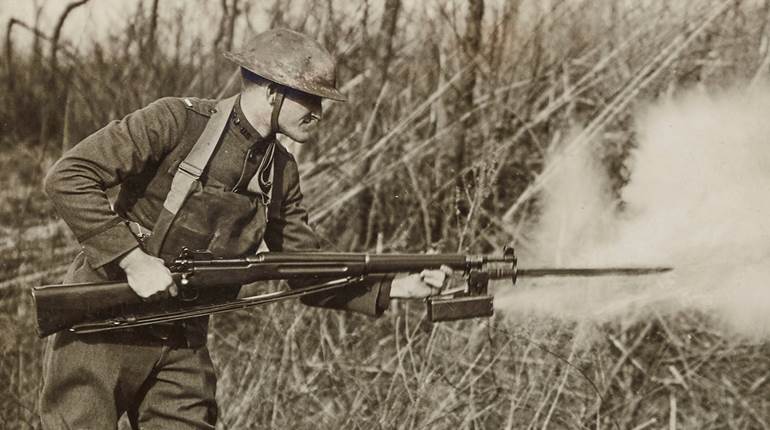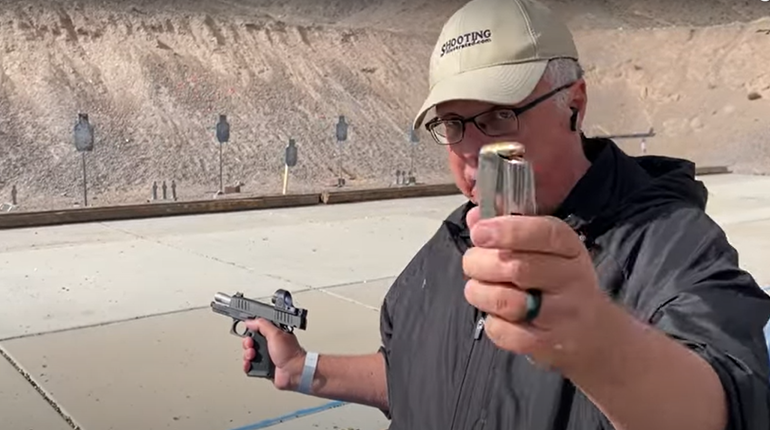
Originally published in Arms & The Man, July 28, 1917
Reams of misinformation, hazards and guesses have been printed during the past two months concerning the United States Enfield. Some of these inaccuracies are of no very great importance. A few of them, however, might be regarded as possible of far-reaching and pernicious results.
Among the statements which should be emphatically denied at the start, and which unfortunately have received wide publicity, is that Springfield ammunition with a chamber pressure varying from 50,000 to 52,000 pounds per square inch will be supplied for use in the Enfield which was designed to resist a pressure of only 42,000 pounds, and that the bolt of the Enfield is weaker than that of the Springfield.
The truth of the matter is that Springfield ammunition will be used in the Enfield, and that the Enfield ammunition exerts only 42,000 pounds per square inch as against the 50,000 or more pounds which the service shell produces. This, however, does not mean that the limit of safety in the Enfield is 42,000 pounds, or that to issue rechambered Enfields to the men who are destined to carry the flag of this Government on French soil will be to place them under the added handicap of a poor, untrustworthy weapon, likely to do as much damage from the breech as from the muzzle.
Unfortunately, authentic information concerning the British Enfield of 1914 is hard to obtain. There was never a manual for this arm. It was a product of the early necessities of the Great War, and men have been too busy using it on the field of battle to stop and write about it.
Concerning the United States Enfield, even less can be told with final authority. It is still in the formative period, and when these rifles are issued they may—or may not—conform exactly to the specifications as planned at present.
There are a few facts which can and should be stated at this time positively and with authority. They are:
That whatever form the United States Enfield may take, its fundamentals will be right. That the Enfield will not supersede the Springfield as the United States service rifle. But that when it is placed in the hands of United States soldiers it will be a thoroughly trustworthy weapon, safe to operate and ballastically accurate.
As yet the Government is not ready to make any official statements concerning the United States Enfield. This is chiefly because many alterations and modifications were necessary, in the opinion of ordnance experts, to make the weapon a satisfactory substitute for the Springfield in case of a shortage of service rifles.
It can, however, be stated on high authority that the United States Enfield will be chambered to take Springfield ammunition; that its ballistics will be relatively the same as those of the Springfield, with the likelihood of a slightly increased muzzle velocity; and that the sights will be the same as those on the British model, retabled to compensate for the difference in ammunition.
To understand just what has been done and what is likely to be done in the development of the United States Enfield, it is well to consider what was accomplished in bringing out the British Enfield of 1914, and the reasons for adopting a modified, rechambered form of this arm as the emergency weapon of the United States.
When the Springfield rifle superseded the Krag, the death-knell of so-called “rim cartridges” was sounded, as far as the United States War Department ordnance experts were concerned.
Not so, however, in England, for the British small-arms designers still held to the rim cartridge at the time the latest models of the Lee-Enfield were produced.
A few years thereafter, however, the British began experimenting upon the rifle which is now known as the Enfield 1914. These experiments had, at the time the European war broke out, reached the point where the protruding magazine of the Lee-Enfield had been discarded, the barrel—shortened in the so-called “Short Enfield”—restored to its present length, and where a .276 rimless cartridge, carrying a cordite charge, had been designed.
This rifle, it is said, produced wonderful results with a 165-grain bullet. The approximate muzzle velocity gained with this charge, it is said, was 3,000 foot-seconds and the muzzle energy 3,300 foot-pounds. Upon such a showing, Great Britain determined to equip both her army and her navy with this new rifle.
But the declaration of war cut short these plans. All of England’s factories at home were equipped to manufacture the old Lee-Enfield. To have changed them would have meant untold delay. Therefore it was determined to manufacture the Lee-Enfield exclusively in Great Britain and to let contracts for the manufacture of the Enfield of 1914 in the United States.
Accordingly, some of the .276 models were sent to this country and their manufacture—rechambered to take the .303 cartridge—begun.
Within a surprisingly short time plants capable in the aggregate of producing more than 10,000 rifles a day had been perfected. In these plants there were more than 17,000 gauges, an equipment which it has been estimated would require the services of thousands of toolmakers many months to produce.
When faced with the necessity of providing an immense reserve of rifles, without an adequate supply of Springfield gauges and jigs, the War Department experts immediately looked over the commercial plants which were already equipped to manufacture military small arms.
The fact that many of these plants could undertake Government contracts immediately, thus insuring quick deliveries, and that to supply all rifles and cartridges this Government will need will not exhaust all the facilities of these factories, were the prime arguments in favor of adopting modified Enfields, although the Ordnance Department does not now and never had regarded the British rifle as superior to the Springfield. Yet they realized that the Enfield is a high-class weapon and that it can be produced in great quantities.
In spite of these advantages, the Enfield of 1914 failed absolutely in one respect to meet the approval of the ordnance experts, and the feature upon which the army officers gagged was the rim cartridge. This, incidentally, may serve to throw some little light upon why the Government did not begin again to manufacture Krags to be the emergency weapon.
It is pointed out that unless rim cartridges are of the finest workmanship, and unless they are fed through the magazine uniformly with the rim of the top cartridge ahead of the rim of the one immediately below it, jams are likely to occur, and have occurred frequently with the Lee-Enfield, the Enfield of 1914, and the Ross military rifle.
It was, therefore, “thumbs-down” on the rim cartridge, and, although the value of ammunition interchangeable between the United States and the English forces was urged, the service cartridge, with the so-called “shoulder lodgment” was selected as the ammunition for the United States Enfield.
From present indications, the United States Enfield will, in general outline, be the same as the Enfield of 1914, notwithstanding the fact that many ordnance officers insist that the design does not appeal to them as much as does that of the Springfield.
Now as to the detailed specifications, so far as is known at the present, of the United States Enfield—
Sights
The United States Enfield will be proved with front and rear sights almost identical with those of the Enfield of 1914, except that the graduations will be altered to compensate for the velocity of the Springfield ammunition.
The front sight consists of an adjustable knife-blade, not greatly different from, although slightly smaller than, that of the Springfield, keyed into a front-sight stud. The sight is protected by a heavy wing on either side, forming a “U,” with the blade in the center.
The rear sight is a receiver sight. On the Enfield of 1914 it was graduated to 1,600 yards at 100-yard intervals. It is provided with an excellent battle-sight peep close to the eye, for use when the leaf sight is prone. The slide on the leaf is equipped with a second aperture sight.
On the Enfield of 1914 is mounted an auxiliary sight for shooting at distances greater than the 1,600 yards provided on the rear leaf, and up to 2,600 yards. This sight consists of a third aperture to the left and rear of the receiver and is used independently of the blade front sight, a rather novel front sight being provided for this auxiliary rear sight just back of the forward sling swivel. This front sight consists of a bar with a button on the forward end and an indicator on the rear end. The indicator works upon a graduated scale of elevation, running from 1,600 yards to 2,600 yards. In adjusting the auxiliary sight, the indicator is moved to the desired elevation, and the sight taken upon the button through the rear aperture. This sight, however, is not regarded as being either practical or necessary and will be omitted from the United States Enfield.
As in the rear sight of the Enfield of 1914, the rear sight on the United States Enfield will not be provided to compensate for windage.
Bolt, Chamber and Magazine
The bolt on the United States Enfield will be the same as that of the Enfield of 1914, with a modification of the ejector to handle rimless cartridges. The statement has been made that the Enfield bolt is not as strong as that of the Springfield. As a matter of fact, many experts regard the Enfield bolt as being stronger, since it has practically the same dimensions as the Springfield, has two safety lugs, and is made of nickel steel. Both the Springfield and the Enfield are modified Mausers, but in the United States Enfield the bolt action will be slightly different from that of the Springfield.
In the Springfield the piece is cocked when the bolt is drawn back, the mainspring being entirely compressed by this action. In the United States Enfield, the compression of the mainspring is only begun when the bolt is drawn back; final compression results when the bolt is closing again and the cocking-piece engages with its sear.
The chamber of the United States Enfield will, of course, be bored for the .30 calibre service ammunition. In addition it will be reinforced so that there will be no possible danger from the greater pressure that the Springfield cartridge exerts. It is pointed out that the receiver, as designed for the Enfield of 1914, was only required to resist a pressure of 42,000 pounds, yet, in fact, is strong enough, being also made of nickel steel, to resist the pressure of the Springfield ammunition. To make assurance doubly sure, however, and to forestall any criticism on the part of those not willing to accept the high resistance of the original receiver as a fact, the reinforcement of receiver and barrel was ordered.
The magazine feed in the British Enfield in principle is not greatly different from the Springfield, and the magazine feed of the United States Enfield will follow that of the British arm, with a modified magazine follower to feed the rimless .30-calibre ammunition. The magazine, while provided with safety lock, has no cut-off.
Rifling
The rifling in the United States Enfield will be quite different from that of the Springfield. In the Springfield there are four grooves, one turn in 10 inches, right hand. The United States Enfield will have an equal number of grooves and lands—five each. The rifling will be one turn in 10 inches, left hand. The diameter of the bore will, of course, be .30.






































